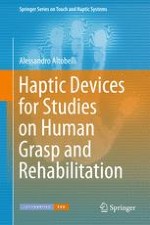In the previous chapter, I evidenced a relation between finger stiffness and EMG signals of principal finger muscles; in this study, I monitored the same muscle activity throughout the grasp of a instrumented manipulandum with different stiffnesses at contact points. To investigate the effect of the stiffness at contact point on the grasping force distribution, I profitably used the tools and method presented in the previous chapters. In effect, grasping of compliant objects presents additional uncertainties and Winges et al. (Winges et al, J Neurophysiol, 101(5), 2447–2458, 2009 [
1]) showed that during a grasp, when one or two contact points are compliant, the activation patterns of finger muscles are different with respect to the case where the contact points are rigid. Besides analyzing the grip forces, to fully understand the control of hand grasping by the CNS, it is important to study how the hand stiffness is regulated during a grasp: stiffening behavior is commonly realized to stabilize movement or to fix posture in isometric tasks (Humphrey and Reed, Adv Neurol, 39, 347–372, 1983, [
2]) and recent findings suggest that to some extent, grip stiffness is independent from grip force (Hoppner et al, Plos one 8(12), e80889, 2013, [
3]). This study (Godfrey et al, Effect of homogenous object stiffness on tri-digit grasp properties, EMBC, 2015, [
4]) aims to investigate the relation between object compliance and grasping stiffness of the hand. To achieve this goal, 11 subjects perform a grasp experiment exploiting a modified version of the manipulandum (see Sect.
2.2) with three different contact modules. Each module is characterized by a certain level of stiffness: rigid, high, medium, or low stiffness. The experiment consisted of four blocks of trials, corresponding to the four different levels of stiffness; in each trial, the subject grasped and lifted the manipulandum 25 times, while the EMG was recorded from the flexor digitorum superficialis (FDS) and extensor digitorum communis (EDC). These two muscles are the main finger antagonist pair and thus can be used to monitor the EMG activity resulting in the production of grasp force as well as overall hand stiffness; this assumption is in agreement with the capability of the human control system to increase hand stiffness exploiting the co-contraction of antagonist muscles (Smith, Can J Physiol Pharmacol, 59(7), 733–747, 1981, [
5]).
